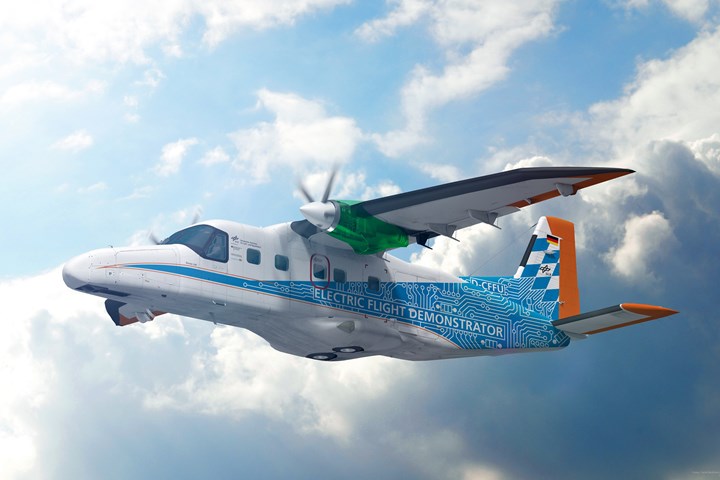MTU Aero Engines highlights potential hydrogen applications
Since the industry’s move toward emission-free aviation, the German engine manufacturer has been developing three additional concepts for hydrogen application.

Photo Credit: MTU Aero Engines
As the industry moves toward emission-free aviation, MTU Aero Engines (Munich, Germany) welcomes the ZEROe concepts from European aircraft manufacturer Airbus. “Hydrogen is a highly attractive future option for us as engine producers as well,” says MTU Chief Operating Officer Lars Wagner. In an effort to realize additional emission-free technologies, MTU is said to see three possible uses for hydrogen, including converting the gas to sustainable aviation fuels (SAFs), converting it into electricity by means of a fuel cell and further development of the gas turbine.
According to MTU, converted to SAFs, hydrogen could be dropped into existing aircraft and engines right away. “Direct combustion of liquid hydrogen in gas turbines is possible in technical terms, too,” says Dr Stefan Weber, senior vice president Technology and Engineering Advanced Programs at MTU, highlighting the second possible use for hydrogen. That would require some adjustments in the engine, especially the combustion chamber, which Weber thinks could be done in just a few years. By contrast, much larger challenges await for infrastructure and aircraft manufacturers, since companies will have to find ways to provide and transport the liquid hydrogen and then carry it along inside appropriate tanks inside the aircraft.
In the long-term, MTU says it is relying on a third option, converting hydrogen into electricity via fuel cell. This application is also described by the MTU experts in its Technology Roadmap for achieving emissions-free flight. This technology promises almost zero emissions, but it is still in the early stages of development in aircraft propulsion applications. “We call our fuel cell concept the “flying fuel cell.” We have an established team of experts working on it in Munich,” Weber explains. In August, MTU teamed up with the German Aerospace Center (DLR) to launch a cooperative project with the aim of demonstrating the new technology in a Do228 turboprop airliner.
MTU’s development work is also focusing on the further development of the gas turbine to leverage the full amount of potential available. The concept is said to have been optimized and combined with revolutionary drive concepts which significantly improve the cycle, and considerably reduce all emissions. MTU is currently focusing on what is known as a WET (Water-Enhanced Turbofan) engine. This concept is said to reduce fuel consumption by more than 15% regardless of fuel type, considerably lowers all emissions — including NOx levels — and, according to initial estimates, also reduces formation of contrails.
Lars Wagner explains: “We need both propulsion concepts — an optimized gas turbine combined with WET technology and fuel cells — because they have different areas of application.” According to the company, the hydrogen-powered fuel cell is especially suitable for short- to medium-haul aircraft, as it requires less tank volume than in the case of long-haul aircraft. For these types of planes, gas turbines will continue to make sense for the foreseeable future. “But in that case, using SAFs,” Dr Stefan Weber sums up, “Realizing the new technologies, and reaching our climate targets, will depend to a crucial degree on receiving appropriate funding, both nationally and at the European level.”
Related Content
Infinite Composites: Type V tanks for space, hydrogen, automotive and more
After a decade of proving its linerless, weight-saving composite tanks with NASA and more than 30 aerospace companies, this CryoSphere pioneer is scaling for growth in commercial space and sustainable transportation on Earth.
Read MoreDevelopment of a composite liquid hydrogen tank for commercial aircraft
Netherlands consortium advances cryogenic composites testing, tank designs and manufacturing including AFP, hybrid winding, welding of tank components and integrated SHM and H2 sensors for demonstrators in 2025.
Read MoreOtto Aviation launches Phantom 3500 business jet with all-composite airframe from Leonardo
Promising 60% less fuel burn and 90% less emissions using SAF, the super-laminar flow design with windowless fuselage will be built using RTM in Florida facility with certification slated for 2030.
Read MorePlant tour: Aernnova Composites, Toledo and Illescas, Spain
RTM and ATL/AFP high-rate production sites feature this composites and engineering leader’s continued push for excellence and innovation for future airframes.
Read MoreRead Next
Next-gen fan blades: Hybrid twin RTM, printed sensors, laser shock disassembly
MORPHO project demonstrates blade with 20% faster RTM cure cycle, uses AI-based monitoring for improved maintenance/life cycle management and proves laser shock disassembly for recycling.
Read MoreScaling up, optimizing the flax fiber composite camper
Greenlander’s Sherpa RV cab, which is largely constructed from flax fiber/bio-epoxy sandwich panels, nears commercial production readiness and next-generation scale-up.
Read MoreCutting 100 pounds, certification time for the X-59 nose cone
Swift Engineering used HyperX software to remove 100 pounds from 38-foot graphite/epoxy cored nose cone for X-59 supersonic aircraft.
Read More












